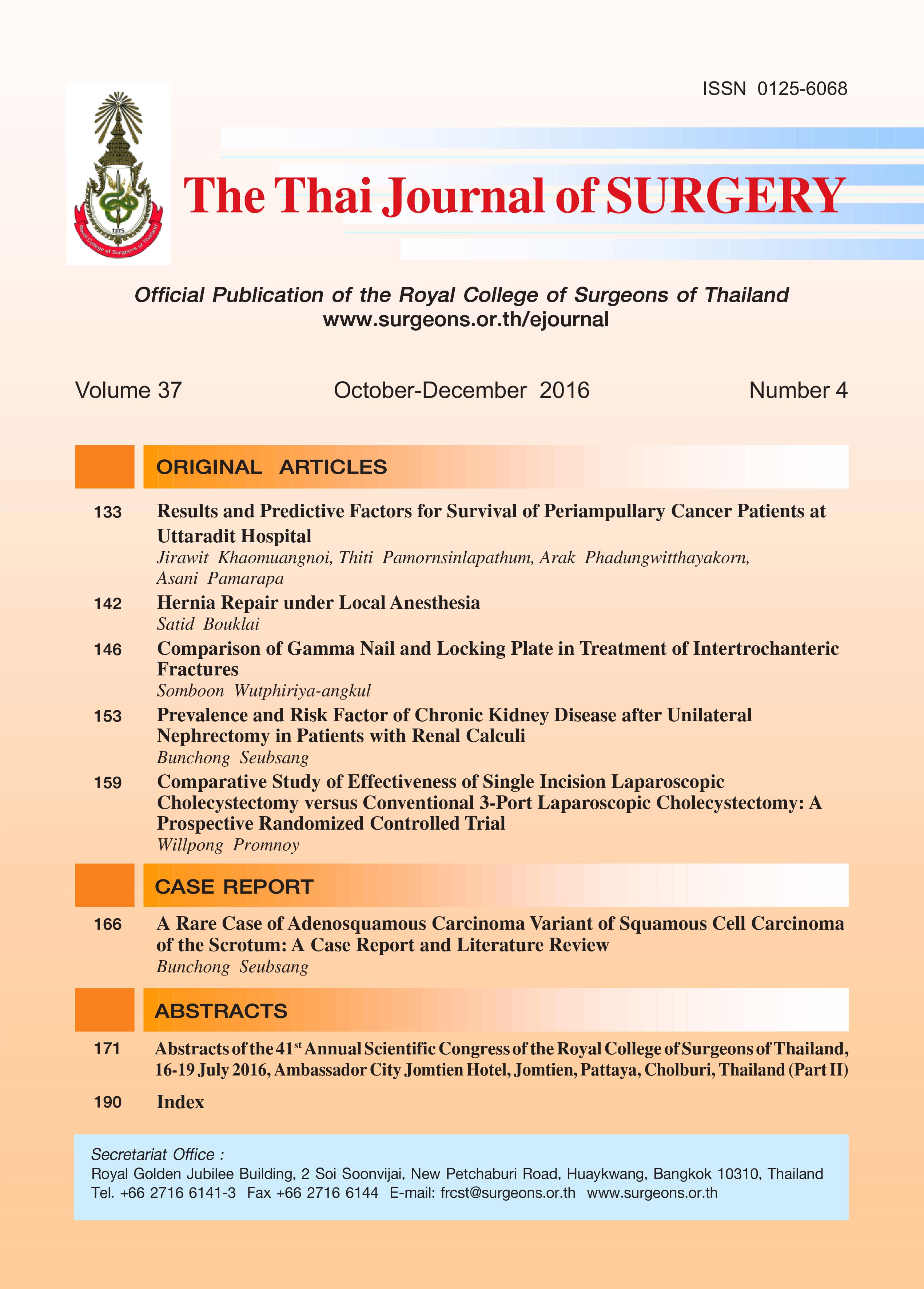Hernia Repair under Local Anesthesia
Keywords:
Hernia repair, local anesthesia, pain controlAbstract
Background and Objective: The author introduces a simple five-step infiltration technique that results insatisfactory local anesthesia and prolonged postoperative analgesia, requiring a maximum of 30 to 40 mL of local
anesthetic solution.
For the last 10 years, more than 200 groin hernia repairs have been performed under local anesthesia
techniques. Initially, field block was the mean of achieving local anesthesia. During the last five years, a simple
infiltration technique has been used because the field block was more time consuming and required larger volume
of the local anesthetic solution. Furthermore, because of the blind nature of the procedure, it did not always result
in satisfactory anesthesia and, at times, accidental needle puncture of the ilioinguinal nerve resulted in prolonged
postoperative pain, burning, or electric shock sensation within the field of the ilioinguinal nerve innervation.
Materials and Methods: More than 200 patients underwent operations at Debaratana Nakhon Ratchasima
Hospital and at Pakthongchai Hospital from January 2007 to December 2015. All patients were assessed preoperatively
by a surgeon and written informed consent was obtained. Patients were monitored intraoperatively for heart rate,
blood pressure and pulse oximetry.
Conclusion: For the last 10 years more than 200 adult patients with reducible groin hernias satisfactorily
underwent operations under local anesthesia without complications.
The preferred choice of anesthesia for all reducible adult inguinal hernia repair is local anesthesia. It is safe,
simple, effective, and economical, without post anesthesia side effect. Furthermore, local anesthesia administered
before the incision produces longer postoperative analgesia because local infiltration, theoretically, inhibits buildup
of local nociceptive molecules and results in better postoperative pain control.
References
cases of elective Groin herniorrhaphy under local anesthesia.
Journal of the Association of General Surgeons of Thailand
under the Royal Patronage of HM the King2010; 6:16-22.
2. Woolf CJ. Central mechanisms of acute pain. In: Bond MR,
CharltonJE, WoolfCJ, editors. Proceedings of the VIth World
Congress on Pain. Amsterdam: Elsevier; 1991. p. 25-34.
3. Dubner R. Neuronal plasticity and pain following peripheral
tissue inflammation or nerve injury. In: Bond MR, Charlton JE,
Woolf CJ, editors. Proceedings of the VIth World Congress
on Pain. Amsterdam: Elsevier; 1991. p. 263-276.
4. Woolf CJ. Recent advances in the pathophysiology of
acute pain. Br J Anaesth 1989; 63:139-46.
5. Tversky M, Cozacov C, Ayache M, et al. Postoperative pain
after inguinal herniorrhaphy with different types of anesthesia.
Anesth Analg 1990;70:29-35.
6. Bugedo GJ, Carcamo CR, Mertens RA, et al. Preoperative
percutaneous ilioinguinal and iliohypogastric nerve block
with 0.5% bupivacaine for post-herniorrhaphy pain
management in adults. Reg Anesth 1990;15:130-3.
7. Arthur GR, Covino BG. What’s new in local anesthetics.
Anethesiology Clin North Am 1988;6:357.
8. Wantz, GE. Atlas of hernia surgery. New York: Raven Press;
1991. p. 19.
9. Bays RA, Barry L, Vasilenko P. The use of bupivacaine in
elective inguinal herniorrhaphy as a fast and safe technique
for relief of postoperative pain. Surg Gynecol Obstet 1991;
173:433-7.
10. Chowdok B, Khaimook A. Comparison of local and spinal
anesthesia for inguinal hernia repair at Hatyai Regional
Hospital: a randomized controlled trial study. Songkla Med
J 2010;28:247-55.
Downloads
Published
How to Cite
Issue
Section
License
Articles must be contributed solely to The Thai Journal of Surgery and when published become the property of the Royal College of Surgeons of Thailand. The Royal College of Surgeons of Thailand reserves copyright on all published materials and such materials may not be reproduced in any form without the written permission.


